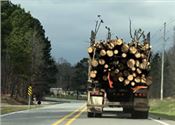2021 Extends The Rollercoaster Ride For Timber Industry

Log truck heading north on Arkansas 9 in Saline County. 2021 was a rollercoaster for the timber business, however, there were plenty of positives.
U of A System Division of Agriculture photo by Mary Hightower
MATTHEW PELKKI AND NANA TIAN
MONTICELLO, ARKANSAS
2021 has been a rollercoaster. Softwood lumber prices have seen at least four wide swings in prices, both up and down, since the pandemic started in 2020. And that roller coaster hasn’t stopped in 2021. With each new wave of COVID-19, the demand for lumber and the production of lumber have been disproportionate, creating tremendous instability in both the lumber and construction industries.
Again in 2021, lumber prices shattered records until May, when housing starts slowed due to the high prices of lumber and related materials such as copper. Composite softwood lumber prices rose from $575 per 1,000 board feet, or MBF, in November of 2020 to $1,500/MBF in May 2021. Prices dropped to under $500/MBF in August, and at the end of 2021 prices have regained some ground and are now just below $700/MBF.
The producer price index, which measures what softwood sawmills receive for sawn lumber in April of 2020 was 111, it spiked to 225 in September 2020 then rose again to 328 in May of 2021. Since then, it has fallen to 134. The tremendous income gains in the industry have been short-term and unstable.
Supply chain, employment
Increased softwood mill capacity of 5 billion board feet in the South has been announced in 2021, but to date lumber production has only increased by 2 percent. The time from an announced capacity increase to the realization of production typically takes two years.
Widespread price instability and supply chain difficulties in trucking and global ocean transport have resulted in shortages in mill equipment. Labor shortages have also slowed the growth in production at sawmills, with signs for signing bonuses for employees at sawmills becoming a common sight in 2021.
Imports of lumber have increased by about 10 percent in 2021, largely from Canada. While this has only increased the total available supply nationwide by 4.5 percent, there have been recent import issues that have caused softwood lumber prices to rise once again in the third quarter of 2021.
One interesting result of the global shipping snarl is that southern yellow pine exports to Mexico have increased by 60 percent, as US lumber has replaced South American (Brazil) lumber that is now much more costly to ship.
Housing starts that were strong in the spring and summer of 2021 have cooled as well, with labor shortages, lumber, and copper prices being cited as the primary factors. Expectations of 1.7 million starts in 2021 are likely to be revised down to 1.5 million. Looking forward to 2022 and 2023, the projections are not good, with housing starts predicted to be less than 1.35 million per year in the coming two years.
While lumber prices have seen wide swings, they have consistently been higher than pre-pandemic levels for softwood lumber, which were $375/ MBF. While prices have increased for standing timber in Arkansas, they have not equaled lumber prices for several reasons. One is the cost of truck transport, which has increased by 22 percent since the pandemic started. Those costs are expected to continue to increase well into 2022. Flatbed rates were $2.20 per loaded mile in early 2020, and they are over $3.00 today.
This rate increase has increased the difference between timber value and lumber value. For landowners in Arkansas, as throughout the South, timber growth is 150 percent of the harvest. Arkansas landowners are producing more timber than mills demand, resulting in a scenario where stumpage prices are not likely to move much, even with greater sawmill capacity.
Softwood timber harvests in 2021 have declined by about 2 percent when compared to 2020, but hardwood timber harvests have increased by nearly 20 percent. Overall, timber harvests have increased only by 0.5 percent because softwood production accounts for 88 percent of all timber harvests in Arkansas.
Stumpage prices paid to landowners for standing trees have increased substantially except for pine pulpwood and hardwood pulpwood. There is a huge oversupply of pine pulpwood in the state, and consumption of hardwood pulpwood by paper mills has declined in 2021.
The third-quarter prices for 2021 and 2020 are provided in the table. ∆
MATTHEW PELKKI AND NANA TIAN: University of Arkansas
Product The statewide average price paid for
standing timber (stumpage) in $ per green ton
2021 Q3 2020 Q3 Price Change
Pine sawtimber $25.75 $23.26 +10.7%
Pine Chip-N-Saw $15.66 $13.70 +14.3%
Pine Pulpwood $5.09 $5.84 -12.8%
Oak sawtimber $52.85 $42.78 +23.5%
Mixed hardwood sawtimber $38.98 $32.29 +20.7%
Hardwood pulpwood $7.14 $7.22 -1.1%